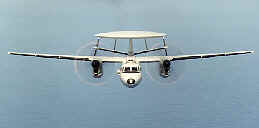The Washington Post recently ran two detailed articles about confusion during heavy fighting in Afghanistan last March, linked here.
My March 2002 editorial was published before Operation Anaconda, and criticized General Franks for trying to run the war in Afghanistan from Florida via cell phones without an overall commander on the ground in Afghanistan. The Washington Post article reported:
 Air Force Brig. Gen. Gregory Trebon ran the Ranger operation that ran into enemy fire from the Bagram air force base. |
"Although Hagenbeck was the senior U.S. military commander in Afghanistan with responsibility for much of Operation Anaconda, he did not control the Ranger mission. That authority fell to Air Force Brig. Gen. Gregory Trebon, who ran a separate unit overseeing special operations. Trebon's command post also was at Bagram, but set apart from Hagenbeck's. A liaison officer who reported to Trebon sat next to Hagenbeck. Trebon declined to be interviewed. "Literally, we were spectators watching," Hagenbeck said. "We did not know what the [SEAL] rescue squad on the ground had been reporting. I still don't know to this day what they reported to the commander here and what was transmitted to the Rangers on board the helicopter -- whether they said there's no other way to get here, or if they said we can suppress the enemy fire, or if they said we're going to lose some guys but it's the only way to do it. We were just looking at a screen without any audio to it."
Hagenbeck's "screen" comment refers to the new expensive Predator UAVs which can circle overhead to provide live video. Too bad he didn't have a World War I era manned airplane above. As a result of this incident, an overall commander has been established in Afghanistan, as this article explains.
New Chief to Take Command of U.S. Troops in Afghanistan
By GREG MILLER, LA TIMES STAFF WRITER, May 15, 2002
WASHINGTON -- The U.S. military plans to install a new commander of American
forces in Afghanistan, marking the first time that a single officer stationed
in the region has been designated to oversee most aspects of the ongoing war.
Army Lt. Gen. Dan McNeill, commander of the 18th Airborne Corps, is expected
to occupy the new post by month's end. Pentagon officials said Tuesday that
the move is designed to streamline the command structure and replace an
arrangement in which the various services report to separate regional leaders.
The change was ordered by U.S. Central Command chief Gen. Tommy Franks, who is
based in Tampa, Fla. McNeill will report to Franks, Pentagon officials said.
Franks "wants to have a subordinate who is doing hands-on,
day-to-day" management of the war, said Marine Corps Gen. Peter Pace,
vice chairman of the Joint Chiefs of Staff. The change in command structure,
Pace said, allows Franks "to spend perhaps a little more time on the rest
of his region," which encompasses 24 other countries.
McNeill will be placed in charge of almost all of the 7,000 U.S. forces in
Afghanistan, although special units will continue to report directly to
Franks, a spokesman said. McNeill also will coordinate efforts involving
thousands of coalition forces from Canada, Britain and other countries.
Airborne Command Aircraft are
Essential
The Washington Post article also revealed:
"At headquarters, commanders tried to notify
the Rangers that the SEALs had retreated from the ridgetop and to direct the
helicopters to another landing zone further down the mountain. Due to
intermittently functioning aircraft communications equipment, the Rangers and
aircrew never received the instructions, according to the official review.
Communication problems also plagued headquarters attempts to determine the true
condition of the SEAL team and its exact location."
This was due to the distance from the headquarters, and interference from the mountains. One of my ten recommendations in G2mil's US Army transformation page (which was published three months ago) is for the Army and Marines to purchase Navy E-2C "Hawkeye" airborne command and control aircraft. (right) The Special Operations Command should also buy some Hawkeyes, especially since they can operate from aircraft carriers. Meanwhile, two Navy Hawkeyes should be immediately dispatched to Bagram for direct support. They can operate from short undeveloped runways to provide direct communications links and control every aircraft within 100 miles while coordinating air support to ground forces.
One of the reasons the US military is having a tough time controlling operations in Afghanistan is that both the US Air Force and Marines eliminated their small propeller-driven OV-10 Broncos, which were key in Vietnam. They refuse to bring any back into service to justify spending billions of dollars on complex and far inferior UAVs. Despite all the excitement about expensive UAVs, the only reconnaissance they can provide is what General Hagenbeck called: "a screen without any audio to it."
Carlton Meyer editorG2mil@Gmail.com
©2002 www.G2mil.com